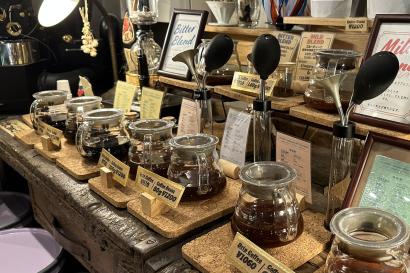It’s been one month since I arrived at Narita Airport in Japan and began my study abroad journey. It’s hard to wrap my head around the reality that time has passed so quickly, and I’m so grateful for all the things I’ve already been able to see, do, and experience. Of course, being in another country often challenges you to see things in different ways, and there are a lot of differences from America and my hometown that I noticed right away. Here are just some of the differences I see and encounter in daily life.
#1. Trash cans—For reasons that I still haven’t been able to figure out, the streets of Japan have an alarming lack of garbage cans. Even in buildings, I have trouble finding a “regular” receptacle for items that aren’t plastic bottles or cans. This means that I frequently end up holding pieces of trash that I have to shove into my pockets because there’s nowhere to throw them away and hope I remember to get rid of them before throwing my pants in the wash. What’s even more mystifying is that there is very little litter out in public on the street…
#2. Sorting garbage—Speaking of trash, the way that Japanese people sort and separate trash for disposal is incredibly detailed and specific. Both in my household and at school, trash is sorted into three major categories: landfill, recyclable, compostable, but while living in an apartment I’ve become keenly aware of the different, and more complicated, Japanese garbage disposal system. The two major categories here are moeru (combustible) and moenai (incombustible), and within the latter, there are more specifications that must be abided by. Plastic bottles, aluminum cans, and glass bottles must all be separated and thrown away separately.
#3. Escalators—When using escalators, people create one long line on the left side to allow people to walk past on the right side. As a bonus, those waiting for the train also form orderly queues behind the lines that indicate where the doors will be when the trains stop, and when the train does arrive people stay to either side, leaving the middle clear for people to exit easily.
#4. Tipping—Like many other countries, Japanese people don’t tip in restaurants because it’s unnecessary (something I wish America would pick up on as well). Bonus: money is usually not handed directly to someone but rather placed on a tray where the other person can pick it up.
#5. Train etiquette—When riding on the train, people refrain from eating, talking on the phone, or talking loudly in general. On incredibly crowded trains, men often put both hands up on a hand strap or rail to make women feel more comfortable and indicate they aren’t going to take advantage of being packed into a tight space to do anything inappropriate.
#6. Greetings—Upon first meeting someone, whether it be a professor or a student your own age, it’s customary to keep some distance between you and the other person and bow, usually by lowering your head slightly for less formal occasions. Shaking hands is not common, even though it’s the standard greeting in America for first-time interactions. When greeting people of the same age whom you’ve met before, I’ve found that a wave works fine, like back home.
#7. Umbrellas—Maybe it’s an odd one to end on, but it’s hard not to notice how often people walking on the street, especially older women, pull out umbrellas in the middle of a sunny day. At least from what I’ve come to know, using an umbrella when it’s not raining in America is bound to have people whispering and making fun of you as you pass by, but here it seems like just another everyday occurrence.

Emery Louie
<p>One of my favorite activities since I was a child is playing the piano, which I picked up when I was about eight years old when I begged my mom to let me take piano lessons. I continued with it all the way up until I was twelve before I eventually gave up because I'd grown tired of being forced to play exclusively classical pieces by long-deceased men. However, I've still continued to play on my own but, because I've lost the ability to read music properly, I learn how to play songs by watching YouTube "synthesia" videos of people playing those songs and following along with the hand positions.</p>







